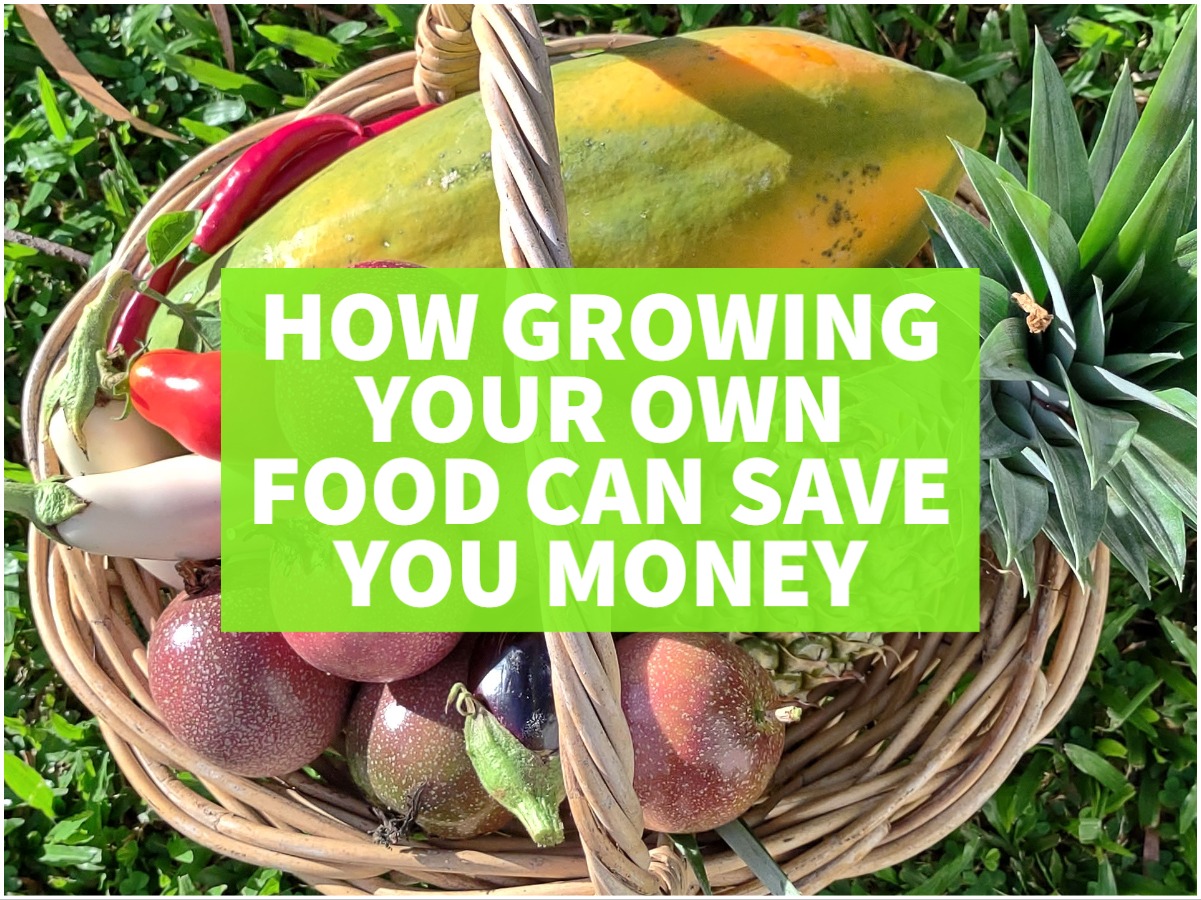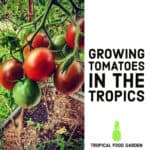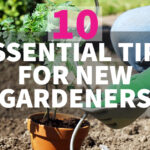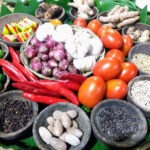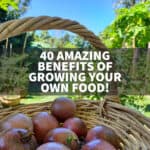This post may contain affiliate links.
People say that gardening is when you spend $300 to grow $1 worth of tomatoes. This can be true for some people, but if you get it right, growing your own fruit and vegetables can be a great way to save money. In these difficult times, with household expenses going through the roof and a depression being threatened, let’s consider if growing your own fruit and veg, or starting a vegetable garden, can save you money or be cheaper than buying food in the shops.

Why Growing Fruit and Veg is Expensive

If you watch a lot of YouTube videos and see people making “vegetable gardens” with raised beds, irrigation and fencing, yes, this is a very, very expensive way to grow fruit and veg. You won’t be saving money by growing your own food for years, maybe never, if you garden this way.
Raw materials to build raised beds and fences are expensive. Ready-made raised beds are expensive, and filling raised beds can be expensive. They contain a huge amount of soil or compost.
You’ll see people filling raised beds with branches and uncomposted materials, yes, this can work in time, but all that stuff takes a while to break down and when it does break down your soil level will have dropped inches. So unless you have no choice, raised beds aren’t the cheap way to go.
The good news is, you don’t usually need raised beds and you don’t need fencing unless you have deer, kangaroos, or chickens destroying your garden. We have a post on chicken proofing your fruit and veg. We have free-range chickens, guinea fowl and geese, and no fences.
I have kangaroos, wallabies, bush turkeys, and chickens trying to eat my plants and I still successfully grow fruit and veg without fencing. There are cheaper ways to keep animals out of your garden. A high fence would be the best way, and the easiest way, if you can afford to pay tradesmen or contractors or buy materials and do it yourself, but it’s not the only way.
Start a Food Garden With No Cost
If you want to start a garden or start growing your own food today, to save money, put a few seeds from store-bought pumpkins in a pot of soil and water them. There, you started!
A large plastic yoghurt tub, an old bucket, a cardboard box, any food-safe container will do. If it’s plastic you will need to make some holes in the bottom for drainage. You should be able to dig up some soil from somewhere, you don’t necessarily need store-bought compost or potting soil to start seeds.
If you have a patch of OK soil, you can put your seeds in the ground directly, there is no need to start pumpkin seeds in pots if you can get them in the ground and keep them watered consistently.
If you’re in a cold climate do this in spring, but in our hot/tropical climate we can start pumpkin seeds at any time of year. They tend to stop producing fruit when it’s very hot or very cold, but we have pumpkins all year.
Now, while your pumpkin seeds are germinating, you can think about how you’re going to fertilize your pumpkin plants and where you’re going to plant them out. Read our post on the various ways to make home-made fertiliser for free. Pumpkin vines give you multiple Kg or pounds of carbohydrate and nutrient-dense food. From 1 seed and very little effort. Pumpkins store for months and are very versatile (pumpkin pie, pumpkin jam, pumpkin curry etc.). Once you’ve made a start, think about growing more food.
Can you grow food from store-bought scraps? Yes, absolutely, we have a post about some of the foods we’ve grown successfully from supermarket food. Our successes have included tomatoes, peppers, chillies, sweet potatoes, passionfruit, celery, ginger and turmeric.
One of the great benefits of growing your own food is that it can be cheaper, and home-grown food can also be more nutrient-dense.
Best Foods To Grow To Save Money
What are the best foods to grow to save money? This depends on your diet, climate, and shopping habits.

The most expensive foods (fresh fruit and vegetables) are often the foods most people eat in small quantities.
So, for instance, chillies (hot peppers) are $30+ per Kg, but not many people sit down to a serving of steamed chillies. (Although Ema Datshi (chilli cheese) is a great recipe to use up a lot of excess chillies).
However, if you grow chillies or hot peppers, you can make your own hot sauce, chilli powder, chili oil, or chili flakes, they’re a great food to make a boring diet more interesting and they’re packed with vitamin C.
If you have a tropical climate, like ours, chillies grow year round and one plant lasts years (they grow as perennials). In colder climates you can bring a chilli plant indoors through winter and get a head start on chili production when the weather warms up.
So for me, as a lover of hot (spicy) food, it’s very worth growing chillies and they do save me money. My first chilli plants I grew from the seeds of a store-bought pepper, so they cost me nothing to grow. You can plant them in the ground or in pots. Give them water and some fertiliser occasionally and they should grow well. We have a post on other plants you can grow from store bought fruits and vegetables.
If you eat a lot of carbohydrates and they form the backbone of your diet, you’ll need to grow potatoes, sweet potatoes, cassava or bananas (green bananas, or plantains). Root vegetables like carrots and parsnips are also rich in sugars (carbohydrates). Bananas are tropical fruits and also the most widely eaten fruit in the whole world.
We eat a very low carb diet for health reasons, so we don’t grow a lot of carbohydrate foods.
If you want vegetable protein you can grow lentils, peas, or beans. All vegetables do contain some protein( just ask a vegan) but legumes are particularly protein rich.
Everyone should eat plenty of green leafy veg and this is what we find hardest to grow. The greens are typically the only vegetables we buy at the supermarket, so far. We do grow a lot of tropical spinach, and we also eat mulberry leaves, pumpkin shoots, and sweet potato leaves from time to time. Sweet leaf is another tropical green that is easy to grow.
Why do we find greens hard to grow? The bugs love to eat them, so do the chickens. We do not use chemical sprays and never will. The tropical greens are fairly bug-resistant, and our perpetual spinach (like chard) never has a bug hole.
If we were starving or particularly short of money, we could be self-sufficient in green leafy veg tomorrow. But we enjoy broccoli, broccolini, fennel bulbs and cauliflower, and we don’t currently grow these vegetables. We do grow kale, kale is an excellent green leafy veg.
Fruit To Grow To Save You Money

We find fruit is the easiest food to grow in the tropics for a year-round food supply. I mentioned already that we don’t eat many carbs, that includes fruit. We have more fruit than we could ever eat. It feeds our chickens, we make our own jam, we never buy fruit.
The fruit we grow that is most useful and saves us the most money has to be lemons. Lemons go into sweet and savoury dishes and are low carb while being rich in vitamin C.
Lemon trees can be very expensive to buy and can take years to produce enough fruit to keep you in lemons year round. But a lemon tree is an investment in your future food supply and health. If you can, get one in the ground today.
After lemons, I’d say grapefruit are the most useful as grapefruit can be a good stand-in for a recipe that calls for lemons. Likewise limes. We have several grapefruit trees and several lemons. Citrus is such a good food to grow and is one of the lower carb fruits, along with berries.
We preserve our lemons year-round by freezing them. You can also freeze lemon juice to use when there are no lemons on the tree.
Papayas (paw paw) give you a lot of fruit bulk and can be used green as a vegetable, that makes them very versatile and useful if you need to grow food to save money. You can also make your own papaya jam and never need to buy jam for your kids again.
Oils and Fats You Can Make at Home
You can make your own coconut oil at home if you can grow or forage coconuts. It’s not an easy process and you need a lot of coconuts to make a small amount of oil so we don’t do this. Instead we make coconut milk.
We buy good olive oil, butter, and ghee at the store. If money was really tight we could go without oils for cooking and dressings, or make coconut oil.
Seed oils may also be possible to make at home, but again, labour intensive and you’d need some sort of oil press.
Tea and Coffee Substitutes You Can Grow To Save Money
You can grow so many herbs, flowers, plants, and roots to make teas and drinks! Turmeric is a good one to grow to make an anti-inflammatory tea.
Tulsi (Holy basil) also grows prolifically in our tropical climate. You could grow camomile, ginger, even mulberry leaves can be used to make tea.
Of course, you can grow tea and coffee too, in the right climate.
Quickest Foods To Grow to Save Money
Radishes are famously quick to grow. If you want food on your plate, fast, consider radishes. You can also eat radish greens. Radishes can be cooked or eaten raw.
Not many people eat a radish-based diet.
Microgreens are very quick to grow, taking just days. A huge variety of seeds can be used to make shoots, sprouts or micro-greens and they’re very nutrient-dense.

Beans and peas are a good fast crop if you need to grow food to cut your grocery bills. When people talk about food plants you can grow in the tropics snake beans are always high on the list. Snake beans grow well in the wet season or tropical summer, but you can also grow French beans or green beans (photo above) in the right conditions.
